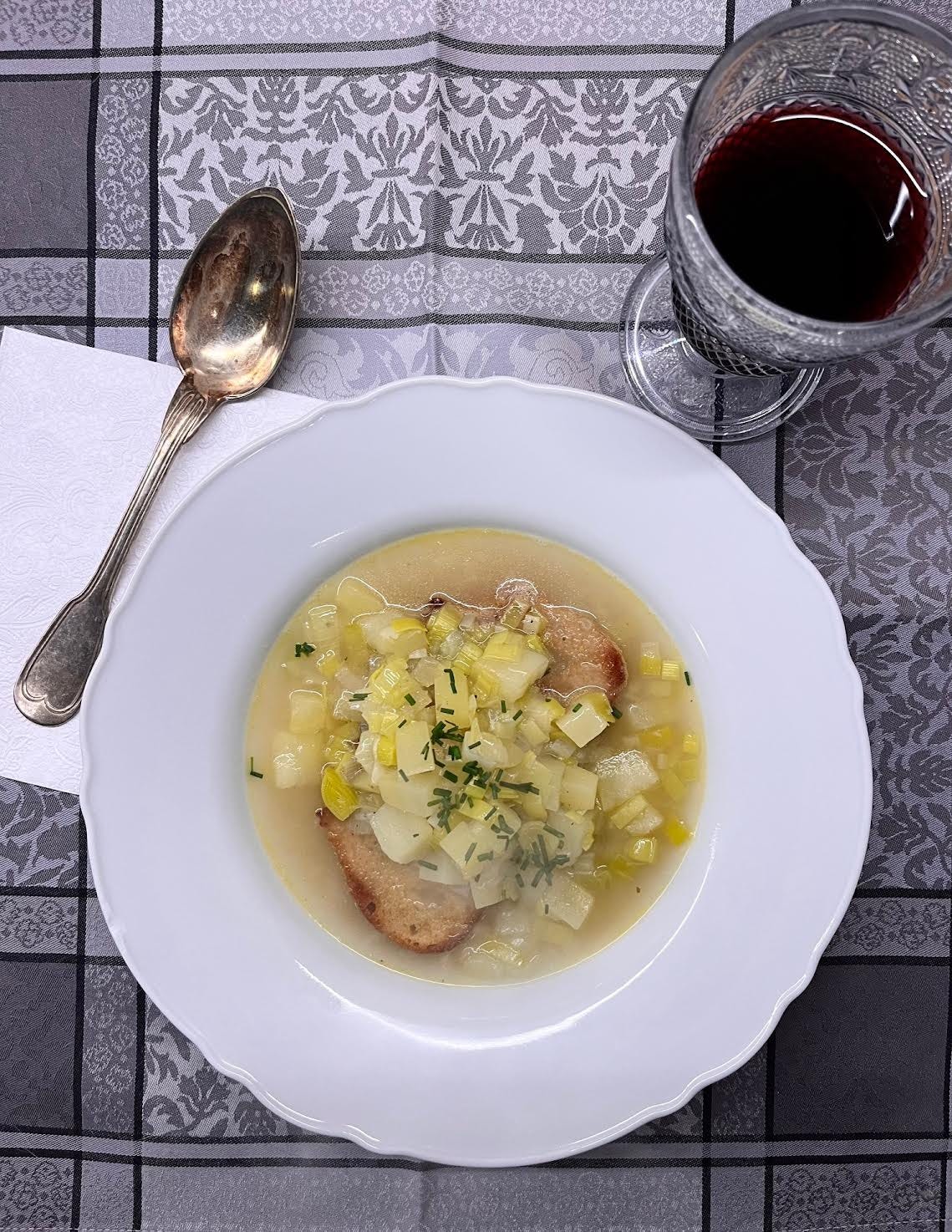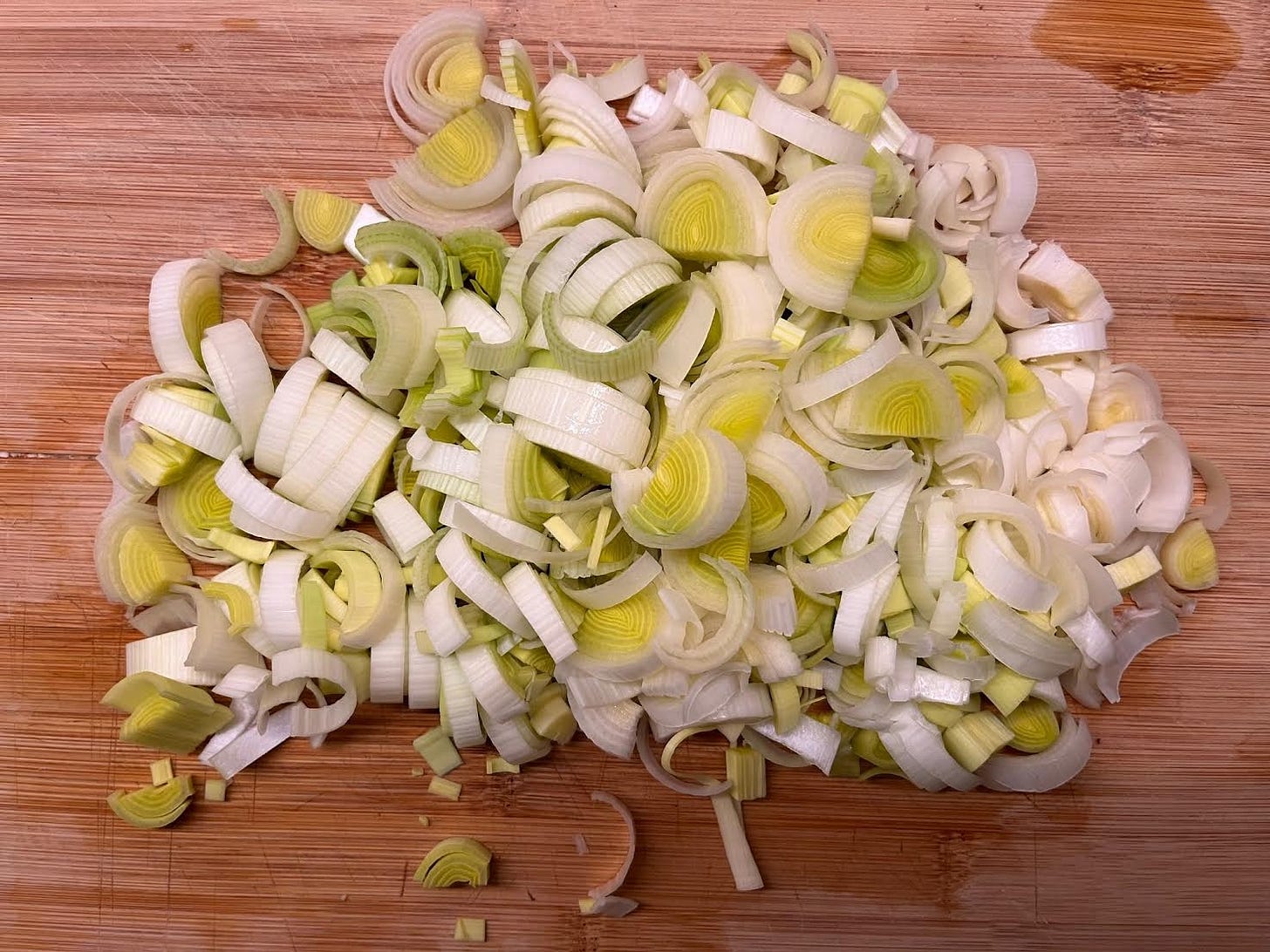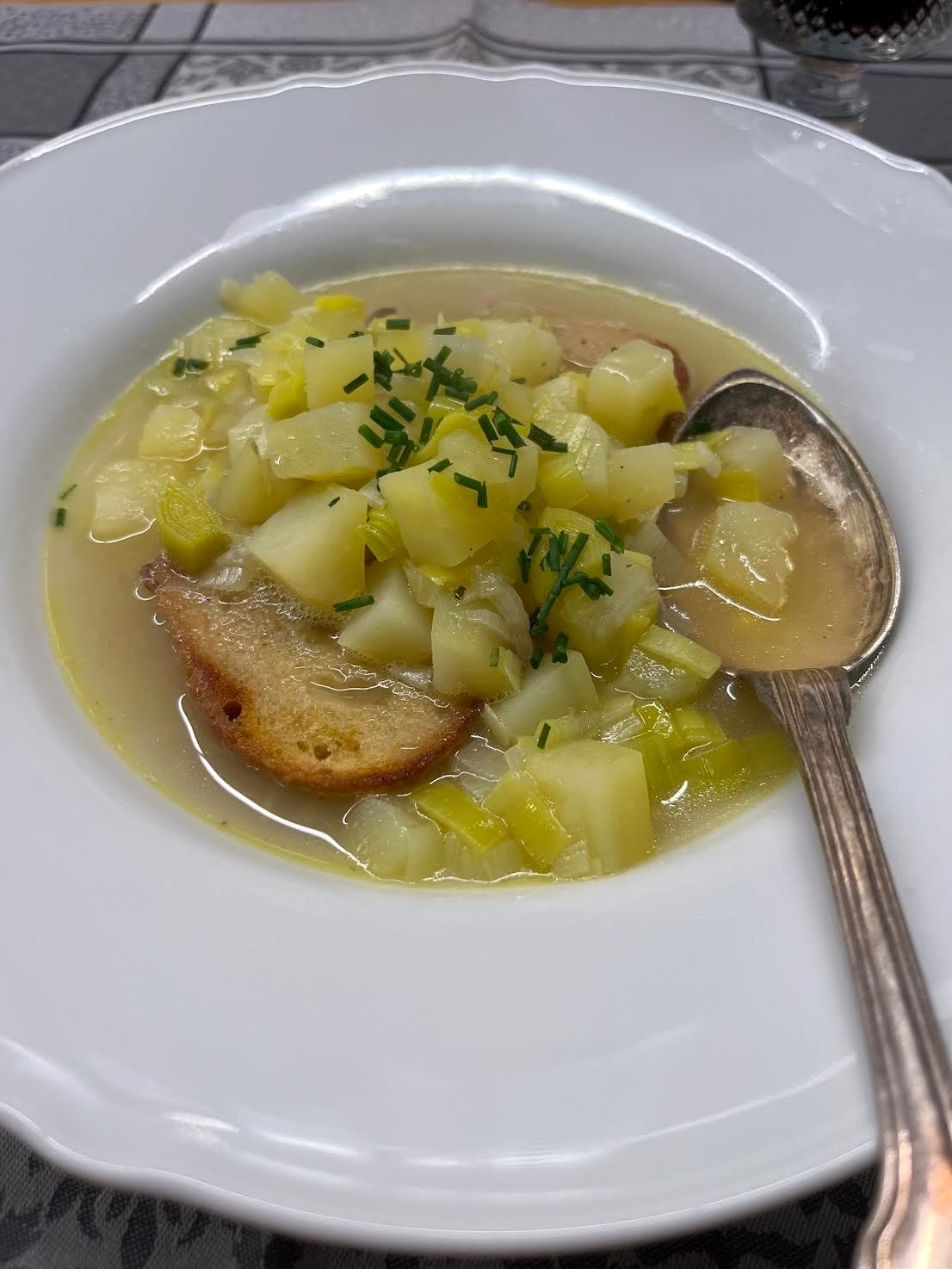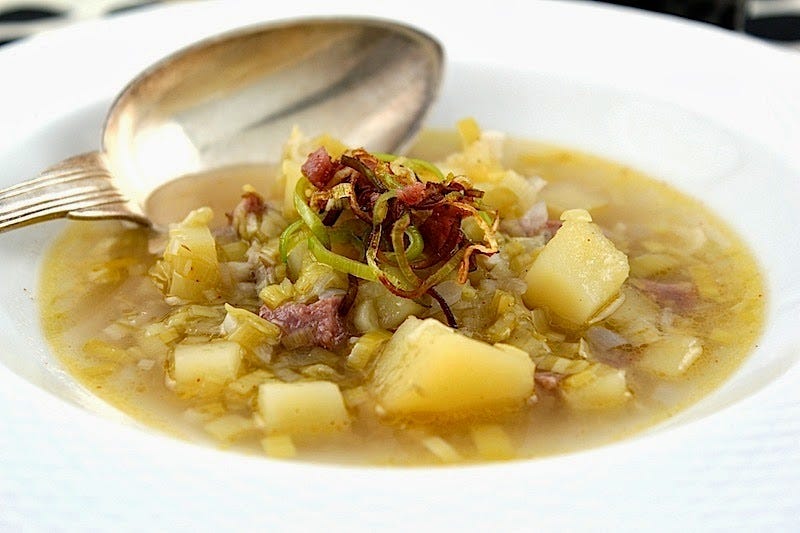"Soup puts the heart at ease, calms the violence of hunger, eliminates the tensions of the day, and awakens and refines the appetite." - Auguste Escoffier
The leek is only useful in the kitchen for putting in the stockpot; it makes the broth taste good.” wrote Joseph Menon in La Cuisinière Bourgeoise, quite succinctly, in 1746.
He expanded on this thought slightly a few years later in Cuisine et Office de Santé Propre à Ceux Qui Vivent avec Oeconomie et Régime (Cooking for Those Who Live with Economy and Diet) in 1757, “(The leek is) good for nothing else among foods, except to impart flavor to broth and garnish soup.” He then adds “It must be cooked well if you don't want it to irritate. It's very good for the chest, and its excessive use can cause headaches, but only two, three or four pieces, depending on their size, should be put in the pot, as this won't cause any discomfort.”
The leek - poireau in French - is an incredibly ancient vegetable; Pliny the Elder wrote about it in his multi-tomed work Natural History, published around the year 77 AD, claiming “This Prince, Nero, for his voice, ate leeks in oil on certain days of the month, abstaining from all other foods, even bread.” Pliny is quoted by Jacques Dalechamps (actually, Pliny is referred to by everyone who wrote about the leek in the centuries to come) in his Histoire Générale des Plantes in 1586/1615, adding “In fact, the viscosity of leeks softens and mellows the throat and, by the same token, the voice.”
But I don’t think the French concerned themselves much with the health benefits - or dangers - of this root vegetable. By the Middle Ages, the leek, like its siblings the onion and garlic, was a popular vegetable in the kitchen, used just the way it is today, as a side dish, yes, but primarily to flavor other dishes and, yes, soups.
One finds the leek in the earliest French cookbooks, from Guillaume Tirel’s Le Viandier (porreaux) in about 1300 and Le Ménagier de Paris of 1393 (poreaux and poireaux) where it is discussed at length and used both as a side dish with almonds and as a flavoring when cooking meat, along with onions and garlic. We see our first recipe for leek soup or potage de poireaux in La Varenne’s 1654 Le Vray Cuisinier François, a simple soup of finely chopped leeks simmered in water to which bread is added at the end of cooking. Nicolas de Bonnefons, whose Les Délices de la Campagne came out in the same year, puts leeks (porreau) in a pot with meat to create a flavorful broth.
“Leeks are used in all households to flavour soups, as they have diuretic properties that can be used in the diet; they are rarely used except as seasoning in French soups.” Alexandre Dumas, Petit Dictionnaire de Cuisine 1882
Soup was the ideal vehicle for leeks. They were cheap and easy to come by. And, as both Menon and Dumas state quite clearly, they weren’t really good for anything else other than as a flavoring, at least not on their own. And, like onions and garlic, the slow cooking in water took away the sharp bite, leaving it mellow, smooth, and delicate. The soups were all quite simple, a simmering of chopped leeks, butter, water, and salt and pepper, with the occasional addition of milk or light broth. And always, as does André Viard in Le Cuisinier National de la Ville et de la Compagne (1853), served over bread or croutons.
But when were potatoes added to the leek soup to create the dish now so common in homes across France? We know that the potato was long considered a curiosity at best, a food for animals at the very least even as it was already a familiar vegetable in kitchens in other parts of Europe. Isn’t it funny how the French were almost always the last to accept a new fruit or vegetable? Some still considered it a poison or strictly medicinal. Until famine hit France around the year 1770. As the French struggled, Antoine-Augustin Parmentier’s pioneering work in turning the potato into food, first for the sick, and then for the hungry, convinced the Paris Faculty of Medicine to officially declare the potato “without danger” in 1772, leading the government to lift the ban on cultivation in the north of France. Little by little, the French accepted the potato and before the middle of the 19th century, the potato had become a staple of French cooking.
And then leek soup became leek and potato soup. We play the game, trying to pinpoint exactly when this happened. And wonder who realized that the potato was the perfect ingredient to add to a leek soup, bulking it up a bit, giving it some toothsome oomph and a little sweetness, adding a rustic, homey quality to the light broth.
The first half of the 20th century, even as potatoes were making their way into chef’s kitchens and cookbooks, the leek soup remained unsullied with the tuber. Antonin Carême, the greatest chef of his day, had an elegant soup under the appropriately-Carême name of Potage de Garbure aux Poireaux, Céleri, et Cresson in his 1833 L'Art de la Cuisine Française au XIXe Siècle, Tome 1: the leek and celery consommé or broth is joined by a handful of chopped chervil and, as is now the custom, served over croutons. Viard, another master chef of the day, has a very simple leek soup in his 1853 Le Cuisinier National de la Ville et de la Compagne.
And then Jules Gouffé, grand pastry chef, wrote Le Livre de Cuisine in 1867, a cookbook intended for both home cooks and apprentices (“without complications of any kind”) and chefs in great kitchens (“la haute cuisine”). He, for the first time, or close to it, incudes recipes for both a Soupe aux Poireaux, a leek soup ("this soup is good only in the season in which this vegetable is tender”) and a Soupe aux Pommes de Terre et aux Poireaux, a potato and leek soup. The first begins with a sauté of chopped leeks in butter, which are then seasoned, simmered in water, enriched with yolks, milk, and more butter, and served over croutons. The latter is a more rustic and homey soup in which the potatoes are added to sautéed leeks, seasoned, and simmered in water. A little butter and thinly sliced bread are “thrown into the pot” before serving. Gustave Garlin adds puréed or mashed potatoes to his Potage aux Poireaux, leek soup, in Le Cuisinier Moderne 20 years later, a version found in other cookbooks of the time. Mme Vatel’s La Bonne Cuisine of 1910 includes a leek and potato soup in her chapter Potages Maigre when meals containing no meat or meat broth are called for, either for dietary reasons or religious, during the period of Lent, for example, or on Fridays.
And now we ask the question: when did leek and potato soup become Soupe Bonne Femme? “Bonne Femme” according to the 1762 Dictionnaire de l'Académie Françoise, “in addition to its ordinary meaning (good woman, familiarly, or sometimes housewife), also means an elderly woman, and is sometimes also used to refer to a woman of little means, a peasant woman.” We have long seen recipes à la ménagère (housewife) and à la paysanne (peasant woman) referring to homestyle dishes, foods that are prepared in simple kitchens, everyday. In the early 19th century we begin seeing recipes à la bonne femme, a new term for a similar style of home cooking. La cuisine bonne femme is a specific, well-defined style of cooking, using only plain, inexpensive ingredients, put together and allowed to simmer on the stovetop or bake slowly in the oven until mealtime, usually served family-style in the recipient in which it was cooked. For a short while, recipes would pop up here and there called this-or-that à la bonne femme, but really with no rhyme or reason: beef sirloin with gherkins à la bonne femme, monkfish à la bonne femme, chicken fricassee à la bonne femme, pie or cake with apricot filling à la bonne femme. Alexandre Dumas has a croûtes au pot à la bonne femme - literally, crusts in the pot - which is nothing more than stale bread soup!
It isn’t until Urbain Dubois, chef and prolific cookbook author, finally grabs the bull by the horns and publishes a first recipe for Soupe à la Bonne Femme in 1871 in his book École des Cuisinières, a soup of curly cabbage and leeks, a pinch of chopped sorrel, a pinch of sugar, and thickened with egg yolks and cream. In 1888, Dubois’s Soupe à la Bonne Femme in Nouvelle Cuisine Bourgeoise is now curly cabbage, leeks, and sorrel, cooked together with water or the liquid from cooked beans, and, finally, he adds diced potatoes. Served over bread croutons, of course. In the same cookbook, Dubois also includes recipes for both a leek and bread soup and a leek and potato soup.
Sometime between Dubois and Austin de Croze’s 1928 Les Plats Régionaux de France, the soupe à la bonne femme has become leek and potato soup. Or vice versa, leek and potato soup is now considered soupe à la bonne femme, or simply soupe bonne femme. “Common to all the provinces of France, it's also the Parisian soup par excellence. Along with pot-au-feu and ragout, it is the culinary link between Paris and the provinces that have conquered it - for Parisians from Paris are rare today.”
De Croze, Escoffier (Ma Cuisine, 1934), Prosper Montagné (Larousse Gastronomique, 1937), and Françoise Bernard (Les Recettes Facile, 1965) all agree that the soupe bonne femme (or à la bonne femme) is still the simple, quick, rustic soup it has always been, whether the early leek soup or the post-Parmentier leek and potato soup, just chopped leeks sautéed in butter, seasoned, and simmered with cubes of potatoes in water or a light consommé (a richer, more complex chicken or meat broth will overpower and hide the delicate flavors of the vegetables). And always, always served over croutons made with stale bread.
Onion soup, garlic soup, leek and potato soup, each one, in their own way emblems of the cuisine bonne femme and quintessential icons of French home cooking: simple, economical, casual but generous. This is the French cuisine I have long wanted to share, that I love sharing with my fellow Americans, with those who only know the sophisticated, more complex recipes. This is the food the French cook and eat every day.
Don’t be tempted to gussy up these recipes with more ingredients or a richer meat stock, to turn it into something it is not; the secret to these very French soups is in the appreciation of the delicate flavors of the vegetables. It is worth training your palate to really taste a broth that, at first mouthful or two, seems bland, almost flavorless. Another spoonful, broth with a bit of the bread, and another, and very quickly you’ll acknowledge how absolutely delicious it is.
Soupe Bonne Femme or Leek and Potato Soup
Serves 2 for a meal, 4 for a small starter. Increase ingredients for more guests, as needed.
6 cups (1 ½ litres) light vegetable or chicken broth or bouillon
3 medium leeks
2 medium potatoes, about 10 ½ ounces (300 grams)
3 tablespoons (about 40 grams) butter
1 bay leaf, optional
Salt and freshly ground black pepper
1 slice of bread per bowl/serving, preferably a country loaf, pain de campagne, or similar
Softened butter or margarine to butter both sides of the bread
Bring the broth just up to the boil then turn off the heat under the pot as you begin the recipe. (I simmered 2 or 3 crushed garlic cloves in the broth until soft even though that is not traditional)
Trim and wash the leeks; peel off the outer layer of each, if necessary. Cut off the green leaves just above where the white turns into green and discard the green leaves. Cut each leek in two lengthwise then chop or thinly slice all of the halves.
Peel, wash, and cut the potatoes into small cubes (not dice… about 1-inch cube); set aside.
Melt the butter in a soup pot; when it’s sizzling, add the chopped leeks and, stirring, cook the leeks until they wilt, about 2 or 3 minutes. Add only about 1 or 2 ladles of the hot broth to the softened leeks, cover the pot, lower the heat and allow to just simmer for 5 minutes (lift the lid and give the leeks a stir every now and then to make sure the liquid hasn’t boiled away).
Remove the lid, add the potato cubes and the bay leaf and season the vegetables with salt and pepper. Add the rest of the broth and bring the soup to a simmer. Allow the soup to simmer for 20 minutes until the potatoes are really tender all the way through.
While the soup is cooking, butter the slices of bread on both sides and brown in a hot pan (preferably nonstick frying pan or a skillet) on both sides.
Place a slice of the grilled bread in each soup bowl and ladle on broth and vegetables. Serve immediately.
The first time my husband made this soup for me, he add a small red onion and 2 cloves garlic, both finely chopped, to the chopped leeks. He added 1.8 ounces (50 grams smoked lardons or cubed bacon to the vegetables as they sautéed. To serve, he quickly fried some finely chopped leeks (or strips) and a bit more lardons/bacon in olive oil until crisp and topped each bowl of hot soup with this garnish.
Thank you for subscribing to Life’s a Feast by Jamie Schler. Please leave a comment; your opinions and feedback help me create the content you want and your stories help build our community. You can support my work by sharing the link to my Substack with your friends, family, and your social media followers. If you would like to see my other book projects in the making, read my other essays, and participate in the discussions, or just support me further, please upgrade to a paid subscription.











Would you be willing to attempt to conquer cassoulet? I would love to hear the history of this wonderful peasant dish.
Fascinating history on Leek and Potato soup. Thank you.